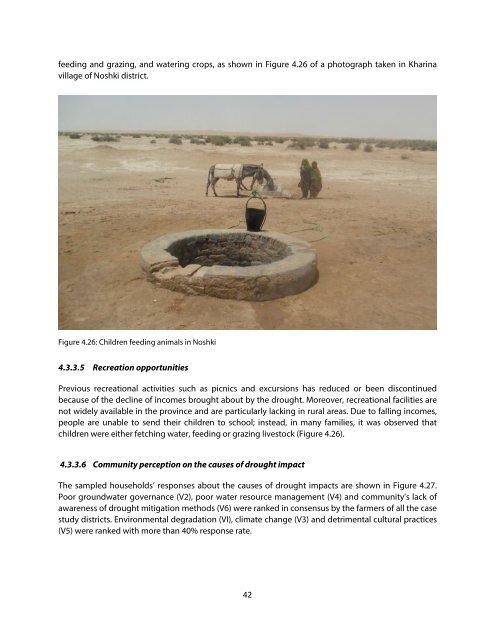Province of Balochistan Pakistan
Drought-Risk-Asst-Balochistan-Nov 2015-lowres
Drought-Risk-Asst-Balochistan-Nov 2015-lowres
Create successful ePaper yourself
Turn your PDF publications into a flip-book with our unique Google optimized e-Paper software.
feeding and grazing, and watering crops, as shown in Figure 4.26 <strong>of</strong> a photograph taken in Kharina<br />
village <strong>of</strong> Noshki district.<br />
Figure 4.26: Children feeding animals in Noshki<br />
4.3.3.5 Recreation opportunities<br />
Previous recreational activities such as picnics and excursions has reduced or been discontinued<br />
because <strong>of</strong> the decline <strong>of</strong> incomes brought about by the drought. Moreover, recreational facilities are<br />
not widely available in the province and are particularly lacking in rural areas. Due to falling incomes,<br />
people are unable to send their children to school; instead, in many families, it was observed that<br />
children were either fetching water, feeding or grazing livestock (Figure 4.26).<br />
4.3.3.6 Community perception on the causes <strong>of</strong> drought impact<br />
The sampled households’ responses about the causes <strong>of</strong> drought impacts are shown in Figure 4.27.<br />
Poor groundwater governance (V2), poor water resource management (V4) and community’s lack <strong>of</strong><br />
awareness <strong>of</strong> drought mitigation methods (V6) were ranked in consensus by the farmers <strong>of</strong> all the case<br />
study districts. Environmental degradation (VI), climate change (V3) and detrimental cultural practices<br />
(V5) were ranked with more than 40% response rate.<br />
42


